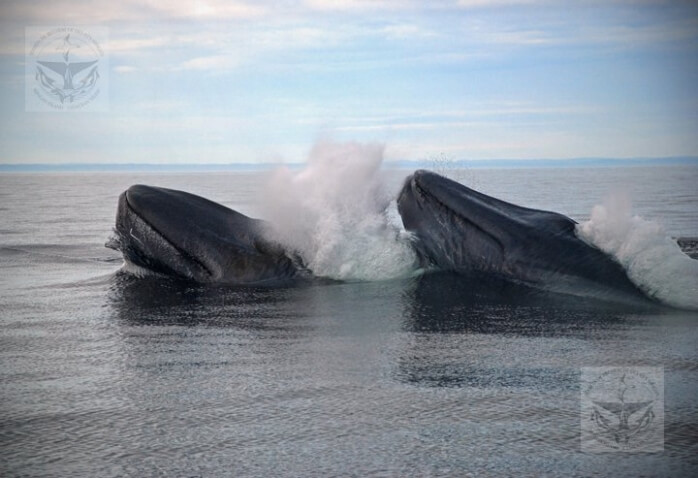A three-way ballet… a race in which body touches body. All around the massive but elegant blue whales, water splashes, spurts, and sprays. On September 13, Richard Sears of the Mingan Island Cetacean Study (MICS) observes what he calls a “rumba” near Île du Corrosol, off the coast of Sept-Îles. Out in front, a female swims at considerable speed while two males chase her using their entire bodies: fins, head, and tail. This contest is believed to be a prelude to reproduction. The trio swims at a good pace toward Mont-Saint-Pierre in the Gaspé Peninsula.
In the St. Lawrence, these “rumbas” occur in early fall. They can go on for several hours until one of the males drops out of the race. The victor becomes the female’s companion. The pair can swim together for several days or even weeks. Do these duos truly result in reproduction between the two individuals? A tough question to answer! To find out, one would need to trace a family tree based on genetics, which would be a formidable challenge.
Two blue whales are seen on the same day, this time near Pointe-aux-Outardes. MICS collaborator René Roy identifies Natalus, but does not recognize the second individual. The mosaic of speckles on blue whales’ flanks can be used to identify them. He also photographs three humpbacks. Surprisingly, none of them is featured in the catalogue. “It’s amazing how many new individuals I have this year, both for blue whales and humpbacks,” he says. Are these young animals on their first visit to the St. Lawrence? Did they change their summer feeding grounds? Or did they simply elude the cameras other years?
“Today was crazy!”, exclaims a couple of observers that made the trek from the US to observe whales at Anse aux Perroquets, east of Les Escoumins. In addition to humpbacks and minke whales, the couple spots a blue whale heading east. “It was HUGE!” She compares the blue whale to an island, while he compares it to a surfacing submarine. A few minutes later, two fin whales approach the shore close enough to observe without binoculars. All that before 10:30 in the morning! “Best whale-watching ever!”, they conclude.
On September 17, a birder takes advantage of the ferry connecting Les Escoumins to Trois-Pistoles to photograph seabirds in good numbers. On the first crossing, in addition to birds in striking plumage, he observes a blue whale, fin whales, humpbacks, belugas and minke whales! On the way back, about halfway across the river, he sees two belugas and… the narwhal! In a single day, he was able to observe six species of marine mammals.
Keep your eyes peeled and you never know what you’ll see! Sitting at the end of the docks in Baie-des-Sables, a fisherman managed to observe a minke whale despite the swell and the winds churning the water surface. The mink whale swims quickly, frolicking and making unexpected turns. He looked just at the right moment, as a few minutes later, the minke whale disappeared offshore, leaving only the beauty of the river to contemplate.







